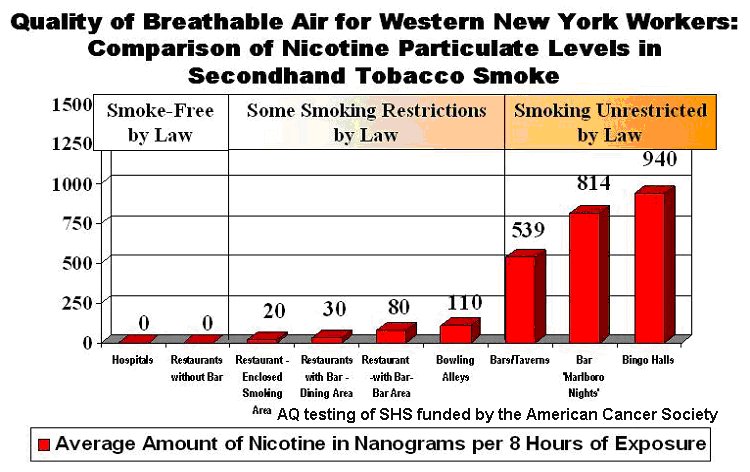Is secondhand smoke a health hazard? Three separate air quality test results prove the answer is NO
Three pro-smoking ban advocate groups tested bar and restaurant air quality across the country to determine secondhand smoke concentrations. They all measured for the trace chemical nicotine, which in turn indicates the concentration level of secondhand smoke present in the air.Why measure for nicotine?
* (As per air quality researchers nationwide) Nicotine is the only unique or "trace" chemical in secondhand smoke. If you measured for formaldehyde, the carpet and other interior sources of formaldehyde would corrupt the test result, formaldehyde is formed naturally in our atmosphere due to photochemical oxidation. Benzene is given off from burning foods in the kitchen or diesel exhaust outdoors so again a false reading would be obtained. Therefore, nicotine is the ideal chemical to measure to determine secondhand smoke concentrations in the air. And then our comparison to OSHA guidelines is the logical manner in which to determine if secondhand smoke levels pose a health hazard, as you can see, according to OSHA, the authority on workplace safety, they do not. If you wanted you could measure every airborne chemical in secondhand smoke and then compare them to OSHA guidelines for each specific chemical, the results would be the same, if not more dramatic.

Test results and comparison to OSHA Standards CFR 29 (see OSHA table link above). The OSHA permissible exposure limit (pel) for nicotine is 0.5 mg (milligrams) / cubic meter.

1) Analysis of St. Louis Park, MN. air quality testing (above) to OSHA table of the nicotine permissible exposure limit (pel). (PEL)'s are the OSHA safe acceptable level of exposure to humans for an 8 hour day, 40 hour per week time period.
1 mg (milligram) / cubic meter = 1000 ug (microgram) / cubic meter. So 0.5 mg / cu. M = 500 ug / cu. M.
OSHA (pel) 500 ug / cu.M. divided by Cafe Europa AQ results 1 ug / cu.M = Cafe Europa seconhand smoke concentrations are 500 times SAFER than OSHA standards.
OSHA (pel) 500 ug / cu.M.divided by Applebees AQ results 3.3 ug / cu.M = Applebees seconhand smoke concentrations are 152 times SAFER than OSHA standards.
OSHA (pel) 500 ug / cu.M.divided by Al's Liquor AQ results 32.5 ug / cu.M = Al's Liquor seconhand smoke concentrations are 15.4 times SAFER than OSHA standards.

2) Analysis of American Cancer Society air quality testing (link above shows ACS test results) against OSHA table of the nicotine permissible exposure limit (pel). (PEL)'s are the OSHA safe acceptable level of exposure to humans for an 8 hour day, 40 hour per week time period.
1 mg (milligram) / cubic meter = 1,000,000 (nanograms) / cubic meter. So 0.5 mg / cu. M = 500,000 nanograms / cu. M.
OSHA (pel) 500,000 nanograms / cu.M. divided by Restaurant with enclosed smoking area AQ results 20 nangrams / cu.M = Restaurant with enclosed smoking area seconhand smoke concentrations are 25,000 times SAFER than OSHA standards.
OSHA (pel) 500,000 nanograms / cu.M.divided by Bowling Alleys AQ results 110 nanograms / cu.M = Bowling Alleys seconhand smoke concentrations are 4,545 times SAFER than OSHA standards.
OSHA (pel) 500,000 nanograms / cu.M.divided by Bingo Halls AQ results 940 nanograms / cu.M = Bingo Halls seconhand smoke concentrations are 532 times SAFER than OSHA standards.
3) MN Group Tests Air Quality in Nonsmoking Sections of Restaurants [12/22-03]
The Pioneer Press Watchdog tested the air in the nonsmoking sections of 20 east-metro St. Paul, MN. restaurants to see how much secondhand smoke diners could expect. The level of nicotine in nonsmoking sections of the 20 east-metro restaurants tested ranged widely, from less-than-1 to 25 ug (micrograms) per cubic meter.
OSHA (pel) 500 ug / cu.M. divided by lowest reading of St. Paul restaurants AQ results 1 ug / cu.M = seconhand smoke concentrations are 500 times SAFER than OSHA standards.
OSHA (pel) 500 ug / cu.M.divided by highest reading of St. Paul restaurants AQ results 25 ug / cu.M = seconhand smoke concentrations are 20 times SAFER than OSHA standards.
The three air quality test results replicated by three separate credible organizations prove that secondhand smoke concentrations when compared to OSHA permissible exposure limits (pel) for secondhand smoke, range between 15 - 25,000 times SAFER than OSHA regulations; in other words NOT A HEALTH HAZARD. (PEL)'s are the OSHA safe acceptable level of exposure to humans for an 8 hour day, 40 hour per week time period.
Clearing the Air strongly suggests that those groups who wish to challenge the validity of smoking bans in court use the above data, which discredits the very core justification for smoking bans.......health hazard.
Also see:
http://cleanairquality.blogspot.com/2007/04/bmj-published-air-quality-test-results.html



 "Though we may not be able to protect your business property rights, we certainly support your Second Amendment Rights"
"Though we may not be able to protect your business property rights, we certainly support your Second Amendment Rights" 

<< Home